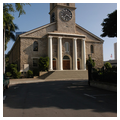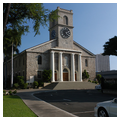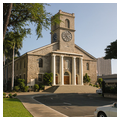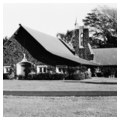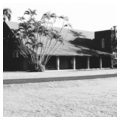Pohaku is the Hawaiian word for stone. Deriving from lava and the coral reef, the types of stone locally available are somewhat limited. Lava rock, the most abundant geomorphic material in Hawaii, assumes a variety of forms. It may have a rough or smooth texture; oftentimes it has been rounded by running streams or pulverized by incessant ocean surf into small stones and pebbles, called iliili. Weathered, highly porous basaltic rocks contrast markedly with the much denser basaltic bluestone, which was formed when lava ponded, or ran in flows which were usually at least twenty feet thick.
In stark juxtaposition to the dark lava rock, coralline materials are a dull white. They derive from a conglomeration of remains from a multitude of living organisms including such animals as coral, mollusks, foraminifera, and bryozoans, all of which secrete limey shells, as well as calcareous algae. The last is the predominant material composing Hawaii's reefs.
Hawaiians from ancient times utilized both lava rock and coralline reef materials as tools and in the construction of a variety of structures, while the sandstone found along the shorelines of Waianae on Oahu, Mana on Kauai, and the island of Molokai was not exploited in any substantial way until historic times.
Constructing with stone, especially on a large scale, was a monumental task for the Hawaiians of old. Unaided by the wheel, the pulley, or such powerful animals as oxen or horses, Hawaiians built heiau temples, fishponds, trails, and holua sled runs, some of which are the largest structures of their kind in the Pacific. At times, lines of people, up to 20,000 in number, stretched for miles to move each stone to a building site. And not all the stones were small; for example, four men were needed to lift a single pohaku into place at Oahu's Kahana fishpond.
With the advent of foreign explorers, traders, and missionaries, the architectural traditions of the Western world were brought to bear on the island landscape. Coral blocks were sawn from the reef off Honolulu Harbor to be used in a number of buildings from the 1830s onward, including Kawaiahao Church (OA58). Mortar, made from coral that was burned in kilns over many nights to make lime, opened the possibility of erecting freestanding, two-story masonry walls that could bear the load of a shingle roof. Churches built by the laypeople, often without pay, were great community endeavors that took five or more years to complete.
As quarrying technologies improved, a number of Hawaii's more substantial late-nineteenth-century buildings were constructed of bluestone. The main building at Bishop Museum in Honolulu (OA3.1) is the earliest cut bluestone building in the Islands, completed in 1890. The quarry which supplied its stone was right at its doorstep. Other buildings utilized stone from the quarry on Magellan Street, now the site of Dole Community Park. Bluestone from Moiliili quarry, where the University of Hawaii's lower campus is now located, can be seen in curbs throughout Honolulu. Thousands of men, many of them prisoners, were employed over the decades to crack stones and work them into shape.
From the 1920s onward, architects have consciously incorporated local stones into many buildings, including the Lihue United Church (KA20), to bestow a regional quality upon them, linking them to the ‘āina land on which they stand.
Writing Credits
If SAH Archipedia has been useful to you, please consider supporting it.
SAH Archipedia tells the story of the United States through its buildings, landscapes, and cities. This freely available resource empowers the public with authoritative knowledge that deepens their understanding and appreciation of the built environment. But the Society of Architectural Historians, which created SAH Archipedia with University of Virginia Press, needs your support to maintain the high-caliber research, writing, photography, cartography, editing, design, and programming that make SAH Archipedia a trusted online resource available to all who value the history of place, heritage tourism, and learning.


